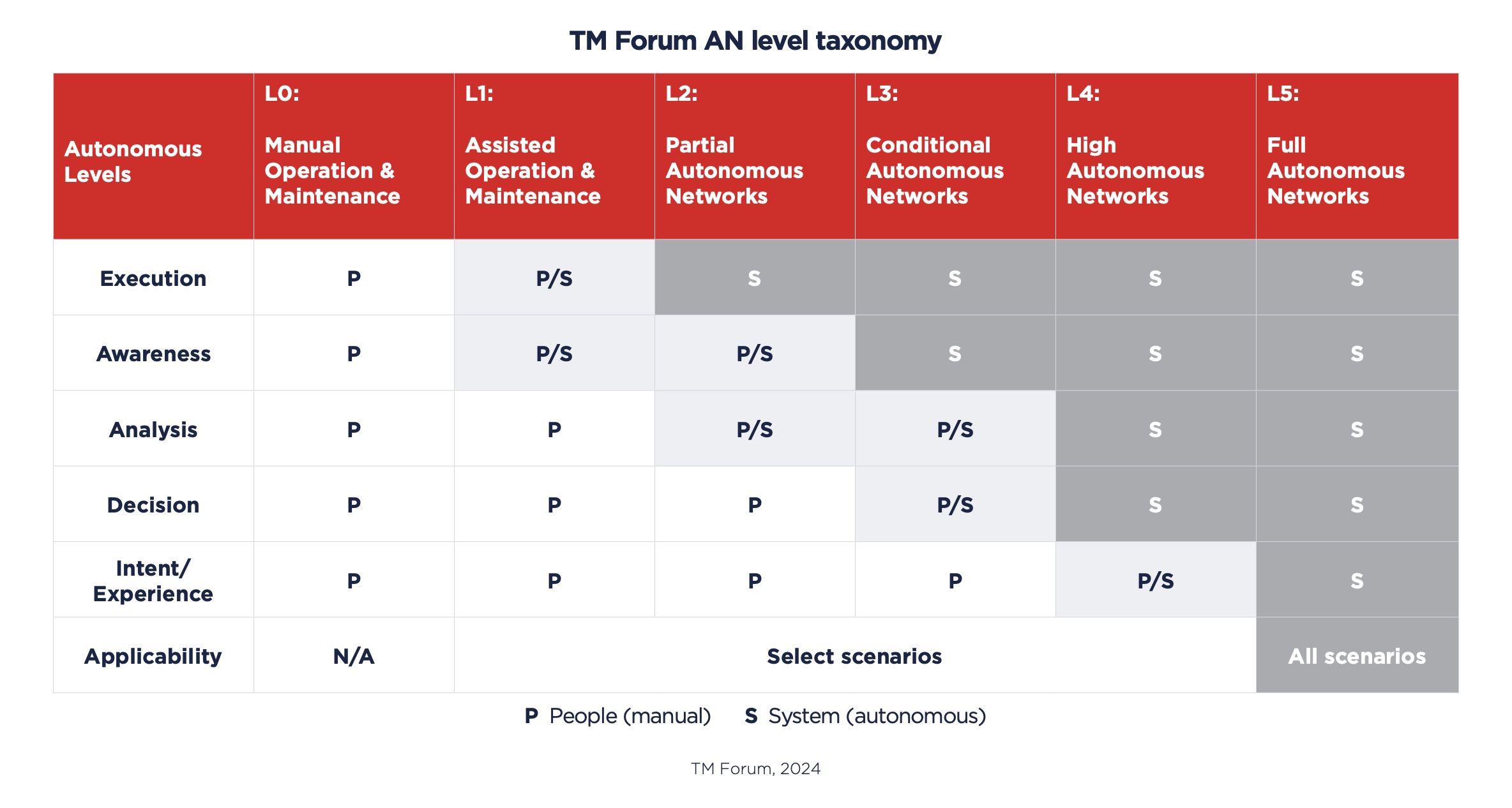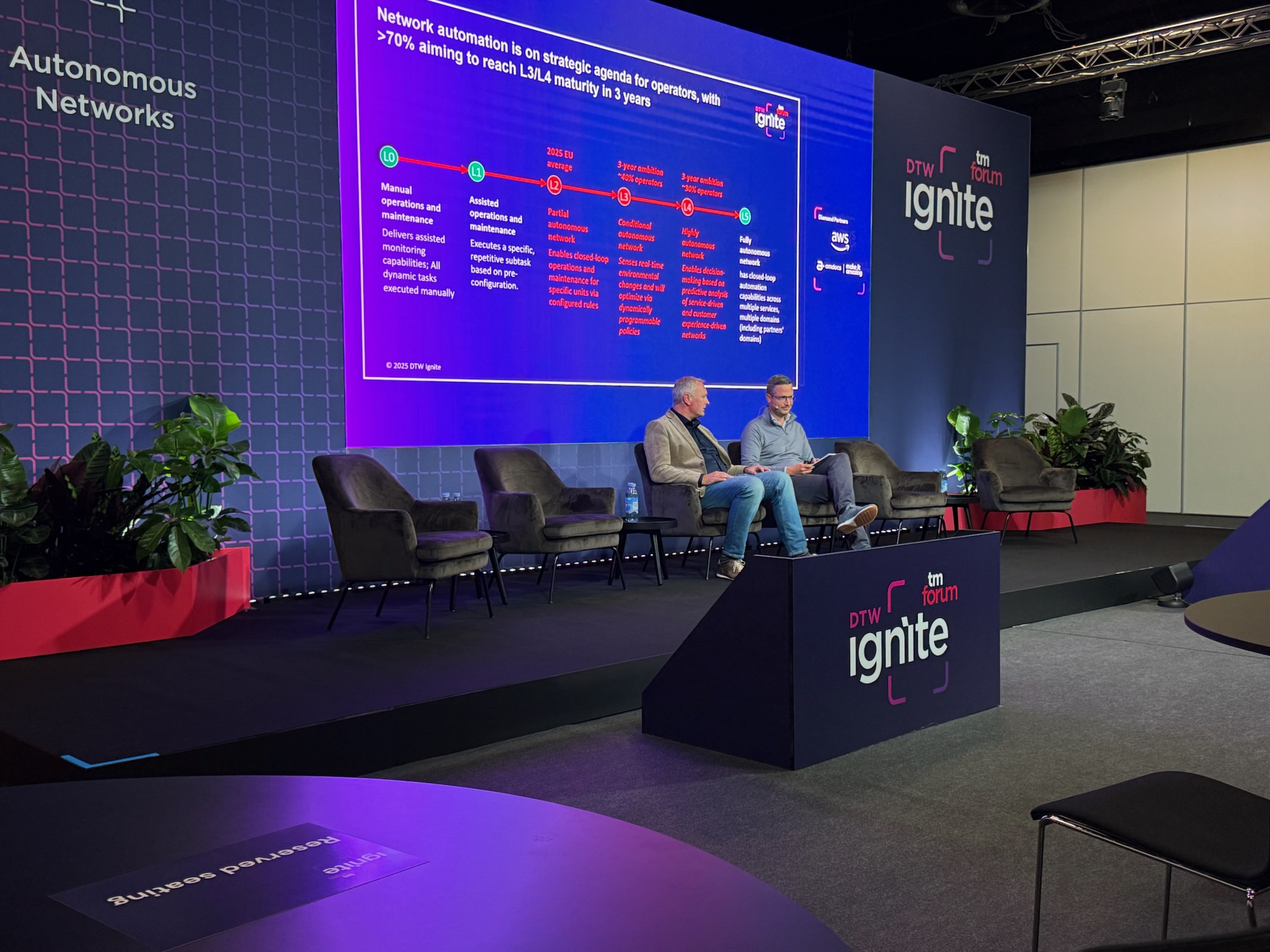Reaching Peak Network Autonomy
The concept of autonomy in the realm of telecommunications represents a pivotal shift in how networks are managed and services are delivered. In theory, full autonomy might be envisioned as a state of complete, self-governing operations, where human intervention is eliminated. This aligns with the aspirational vision of fully autonomous networks, capable of self-configuration, self-healing, and self-optimization. However, the practical reality is far more nuanced. Achieving full autonomy across complex, dynamic telecom environments presents significant challenges, leading to a critical question: Is full autonomy always the ultimate goal, or is there an optimal level of autonomy that balances efficiency, cost, risk, and human oversight?
Artificial Intelligence (AI) is rapidly emerging as a transformative force in this evolving landscape. Its growing role in network operations and service delivery is enabling unprecedented levels of automation and intelligence, moving beyond traditional scripting and rule-based systems to more adaptive and predictive capabilities.
To provide a standardized framework for understanding and measuring autonomy in networks, the TM Forum® and its members have developed a widely recognized maturity model, classifying autonomous networks into six distinct levels (L0 to L5):
- L0 (Manual Operations): At this foundational level, all network operations, including configuration, monitoring, fault management, and service provisioning, are performed manually by human operators. There is minimal to no automation in place.
- L1 (Assisted Operations): This level introduces basic automation for repetitive and routine tasks. Human operators are still heavily involved in decision-making, analysis, and execution, but they are assisted by tools and scripts that streamline certain processes. The primary goal is to increase operational efficiency for specific subtasks.
- L2 (Partial Autonomous Networks): Automation extends to specific domains or functions within the network, allowing for automated execution of certain tasks or processes. While some closed-loop automation may exist within these isolated domains, human intervention is still required for cross-domain coordination, complex problem-solving, and overall strategic decision-making. This level often involves partial automation of operations and maintenance.
- L3 (Conditional Autonomous Networks): This level signifies a more advanced stage where automated operations span multiple domains, with some degree of cross-domain coordination. The system gains the ability to analyze situations and make decisions autonomously in predefined scenarios. However, human oversight remains critical for handling complex or unforeseen situations, and for validating decisions before execution. This is often characterized by conditional automation, where human approval is needed for certain actions.
- L4 (High Autonomous Networks): At this level, automation is extensive and dynamic, covering most operational processes across multiple domains. The system can analyze and make decisions in a wide range of complex scenarios, often with minimal human intervention. Human involvement is primarily reserved for governance, ethical considerations, strategic planning, and managing rare exceptions that fall outside the system’s learned parameters. This represents a significant leap towards self-governing capabilities.
- L5 (Full Autonomous Network): This is the pinnacle of network autonomy, characterized by complete, end-to-end automation across all network domains. The system is fully self-configuring, self-healing, and self-optimizing, operating with no human intervention. Human roles are limited to high-level strategic direction and extreme, unforeseen circumstances. This level embodies a truly zero-touch operational model.
To assist telecom operators in evaluating and comparing the maturity of their autonomous networks, TM Forum has created the Autonomous Network Levels Evaluation Tool (ANLET).

Challenges to Autonomy
It is important to clarify that, as of today, there are no telecom operators who have reached L5 full autonomous networks. The journey to higher levels of autonomy is complex and ongoing. Several factors contribute to this, including:
- Cultural resistance: A significant barrier is the human element. Employees may fear job displacement, loss of control, or a lack of understanding of AI-driven decisions. This can lead to resistance to change and a reluctance to fully embrace autonomous operations.
- Unclear ROI on autonomous networks: The upfront investment in technologies and processes required for higher levels of autonomy can be substantial. Operators may struggle to clearly quantify the financial benefits, making it difficult to justify the investment, especially when competing with other strategic priorities. While some studies suggest significant ROI, the perception of unclear returns can slow adoption.
- Legacy infrastructure and systems: Many existing telecom networks are built on complex, siloed legacy systems (OSS/BSS). Integrating new AI-driven autonomous solutions with these older systems is a massive undertaking, often fraught with technical difficulties and high costs. This complexity can derail automation efforts.
- Technological feasibility: Even in cases where legacy systems are not a constraint, the technology required to support full autonomy is not yet fully available. Level 5 capabilities—such as strategic decision-making, self-evolving policies, and autonomous intent generation—depend on technologies like Artificial General Intelligence (AGI), which remain in early stages of development. As a result, some autonomy goals are currently beyond reach.
- Trust in AI-driven decisions: A critical aspect is building trust in AI systems. Operators need to be confident that autonomous systems will make correct and reliable decisions, especially in critical network operations.
- Skills and talent: Moving from traditional operations to AI-enabled autonomy demands specialized expertise in areas such as DevOps, MLOps, and AIOps. Many telecom operators face significant challenges in attracting, developing, and retaining such talent. This is not merely a cultural issue—it is a structural skills gap. Without the right human capital, even the most advanced tools cannot be effectively deployed or scaled.
According to recent research by the Capgemini Research Institute, conducted in collaboration with TM Forum, 84% of telecommunications operators currently operate at Level 1 or Level 2 autonomy, with 61% of operators planning to achieve at least Level 3 autonomy within the next five years. However, despite this growing ambition, most use cases remain at the proof-of-concept stage. And while they recognize the benefits of higher autonomy, they are often ‘stuck’ due to a combination of the factors aforementioned, particularly the challenges of integrating disparate systems and overcoming internal cultural resistance.

Peak Autonomy vs. Full Autonomy
While the concept of full autonomy might seem like the ultimate goal, not all telecom operators are actively pursuing it, nor do all contexts benefit from it. The desirability of full autonomy often clashes with practical realities, leading many to aim for an optimal level rather than the maximum.
For many operators, achieving L5 is neither necessary nor desirable given their specific business needs and operational contexts. Instead, levels like L3 or L4 may represent their practical “peak autonomy,” offering substantial benefits without the prohibitive costs and complexities of L5.
Peak autonomy can be defined as the maximum beneficial level of autonomy within a given system or context. This does not necessarily mean reaching the highest possible level (L5), but rather identifying the point where the benefits of increased autonomy—such as efficiency, cost reduction, faster service delivery, and improved reliability—are maximized, while associated complexities, risks, and investments remain manageable. Beyond this point, the marginal gains may diminish, or the trade-offs may outweigh the benefits.
Peak Autonomy in Telecom: What It Looks Like
For telecom operators, achieving higher levels of autonomy translates into tangible benefits across various operational domains. While L5 full autonomy remains a distant goal for most, significant progress is being made in implementing advanced automation and AI-driven capabilities that exemplify peak autonomy in practical terms.
Here are a few examples:
Network Operations
- Predictive maintenance: AI and machine learning models analyze vast amounts of network data (e.g., sensor readings, performance metrics, historical fault data) to predict potential equipment failures or performance degradation before they occur. This allows operators to proactively schedule maintenance, replace components, and prevent service outages, shifting from reactive to proactive network management. This reduces downtime and operational costs.
- Closed-loop fault detection and resolution: This involves automated systems that can detect network faults, diagnose their root causes, and initiate corrective actions without human involvement. This closed-loop automation significantly reduces the time to resolve issues, minimizes service impact, and improves network reliability. It moves beyond simple alarms to intelligent analysis and automated remediation.
Customer Experience
- Personalized service delivery: AI enables telecom providers to offer highly customized services and experiences based on individual customer behavior, preferences, and usage patterns. This includes personalized product recommendations, tailored service plans, and proactive support based on predicted needs.
- Intent-Based service provisioning: While still in early stages, this involves translating high-level business intents (e.g., “provide high-bandwidth connectivity for a new enterprise customer”) into automated network configurations and service deployments. AI interprets the intent and orchestrates the necessary network changes, enabling rapid and error-free service provisioning.
Service Delivery and Lifecycle
- Zero-touch onboarding and provisioning: Automation streamlines the process of onboarding new customers and provisioning services, eliminating manual steps and reducing errors. This enables faster service activation and a seamless customer experience.
- Dynamic service scaling: Networks can automatically scale resources up or down based on demand fluctuations, ensuring optimal performance and efficient resource utilization. This is particularly crucial for managing traffic spikes and supporting dynamic services.
Human + Machine: Not an Either/Or
The increasing autonomy in telecom networks does not signal the end of human involvement. Instead, it marks a shift in workforce roles—from manual operators to orchestrators, overseers, and strategic decision-makers. The relationship between humans and machines in autonomous networks is symbiotic, not a zero-sum game.

As our CEO, who is also a Co-chair on the Measuring and Managing Autonomy (MAMA) Project at the TM Forum®, Luqman Shantal, puts it, “The more systems automate, the more humans matter.” In his keynote at DTW, he emphasized that in an era where machines optimize decisions and processes, it is human qualities like emotional clarity, strategic discernment, and the ability to lead through uncertainty that become the defining advantages. Automation may handle the technical, but it is human insight that guides direction, inspires confidence, and transforms complexity into coordinated action.
We believe that even at the highest autonomy level, human oversight should remain essential—especially in areas such as governance, ethics, exception handling, and strategic alignment, where AI lacks judgment and contextual awareness. To meet these demands, telecom professionals must build new capabilities in data literacy, AI oversight, critical thinking, and communication—ensuring effective human-AI collaboration across autonomous network operations.
In conclusion, peak autonomy in telecom is not about reaching a theoretical maximum, but about finding the most effective and beneficial level of automation for a given context. It is a journey of continuous improvement, driven by AI and data, and characterized by a collaborative human-machine partnership that prioritizes optimal outcomes over absolute automation. The road ahead is not about a single destination, but a series of evolving milestones that enable telecom operators to build more resilient, efficient, and customer-centric networks for the future.
Reaching Your Peak Network Autonomy
Reaching your peak network autonomy starts with a clear understanding of where you stand today. Telecom operators must begin by assessing their current level of network autonomy—technically, operationally, and organizationally. This as-is assessment helps define a realistic target: the next level of maturity that aligns with their business priorities and operating context.
From there, the journey forward doesn’t have to be disruptive. Instead of large-scale transformations, operators can move through iterative steps—pilots, focused initiatives, or domain-specific upgrades. This Minimum Viable Transformation (MVT) approach reduces risk, builds internal momentum, and delivers measurable impact without overwhelming the organization.
There’s no universal blueprint. But with the right foundation, a clear ambition, and a pragmatic path forward, operators can advance toward smarter, more autonomous networks—at a pace and scale that works for them.